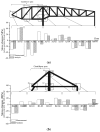A practical monitoring system for the structural safety of mega-trusses using wireless vibrating wire strain gauges
- PMID: 24351640
- PMCID: PMC3892886
- DOI: 10.3390/s131217346
A practical monitoring system for the structural safety of mega-trusses using wireless vibrating wire strain gauges
Abstract
Sensor technologies have been actively employed in structural health monitoring (SHM) to evaluate structural safety. To provide stable and real-time monitoring, a practical wireless sensor network system (WSNS) based on vibrating wire strain gauges (VWSGs) is proposed and applied to a building under construction. In this WSNS, the data measured from each VWSG are transmitted to the sensor node via a signal line and then transmitted to the master node through a short-range wireless communication module (operating on the Industrial, Scientific, and Medical (ISM) band). The master node also employs a long-range wireless communication module (Code Division Multiple Access-CDMA) to transmit the received data from the sensor node to a server located in a remote area, which enables a manager to examine the measured data in real time without any time or location restrictions. In this study, a total of 48 VWSGs, 14 sensor nodes, and seven master nodes were implemented to measure long-term strain variations of mega-trusses in an irregular large-scale building under construction. Based on strain data collected over a 16-month period, a quantitative evaluation of the construction process was performed to determine the aspects that exhibit the greatest influence on member behavior and to conduct a comparison with numerical simulation results. The effect of temperature stress on the structural elements was also analyzed. From these observations, the feasibility of a long-term WSNS based on VWSGs to evaluate the structural safety of an irregular building under construction was confirmed.
Figures












Similar articles
-
An integrative structural health monitoring system for the local/global responses of a large-scale irregular building under construction.Sensors (Basel). 2013 Jul 15;13(7):9085-103. doi: 10.3390/s130709085. Sensors (Basel). 2013. PMID: 23860317 Free PMC article.
-
A wireless laser displacement sensor node for structural health monitoring.Sensors (Basel). 2013 Sep 30;13(10):13204-16. doi: 10.3390/s131013204. Sensors (Basel). 2013. PMID: 24084114 Free PMC article.
-
Wireless laser range finder system for vertical displacement monitoring of mega-trusses during construction.Sensors (Basel). 2013 May 6;13(5):5796-813. doi: 10.3390/s130505796. Sensors (Basel). 2013. PMID: 23648650 Free PMC article.
-
A comparative study of wireless sensor networks and their routing protocols.Sensors (Basel). 2010;10(12):10506-23. doi: 10.3390/s101210506. Epub 2010 Nov 24. Sensors (Basel). 2010. PMID: 22163483 Free PMC article. Review.
-
Energy scavenging for long-term deployable wireless sensor networks.Talanta. 2008 May 15;75(3):613-23. doi: 10.1016/j.talanta.2007.12.021. Epub 2007 Dec 26. Talanta. 2008. PMID: 18585122 Review.
Cited by
-
Smart Polymer Composite Deck Monitoring Using Distributed High Definition and Bragg Grating Fiber Optic Sensing.Sensors (Basel). 2022 May 27;22(11):4089. doi: 10.3390/s22114089. Sensors (Basel). 2022. PMID: 35684713 Free PMC article.
-
Maximum stress estimation model for multi-span waler beams with deflections at the supports using average strains.Sensors (Basel). 2015 Mar 30;15(4):7728-41. doi: 10.3390/s150407728. Sensors (Basel). 2015. PMID: 25831087 Free PMC article.
-
Measurements of Dynamic Deformations of Building Structures by Applying Wire Sensors.Sensors (Basel). 2019 Jan 10;19(2):255. doi: 10.3390/s19020255. Sensors (Basel). 2019. PMID: 30634673 Free PMC article.
-
Temperature and Strain Correlation of Bridge Parallel Structure Based on Vibrating Wire Strain Sensor.Sensors (Basel). 2020 Jan 24;20(3):658. doi: 10.3390/s20030658. Sensors (Basel). 2020. PMID: 31991640 Free PMC article.
References
-
- Doherty J.E. Nondsestructive Evaluation. In: Kobayashi A.S., editor. Handbook on Experimental Mechanics. 2nd ed. Society for Experimental Mechanics, Inc.; Bethel, CT, USA: 1987.
-
- Arditi D., Gunaydin H.M. Total quality management in the construction process. Int. J. Proj. Manage. 1997;15:235–243.
-
- Aktan A.E., Catbas F.N., Grimmelsman K.A., Tsikos C.J. Issues in infrastructure health monitoring for management. J. Eng. Mech. Asce. 2000;126:711–724.
-
- Brownjohn J.M.W. Structural health monitoring of civil infrastructure. Philos. T. R. Soc. A. 2007;365:589–622. - PubMed
-
- Liu S.C., Tomizuka M. Vision and Strategy for Sensors and Smart Structures Technology Research. Proceedings of the 4th International Workshop on Structural Health Monitoring; Stanford, CA, USA. 15–17 September 2003; Lancaster, PA, USA: DEStech Publication, Inc.; 2003.
Publication types
LinkOut - more resources
Full Text Sources
Other Literature Sources

